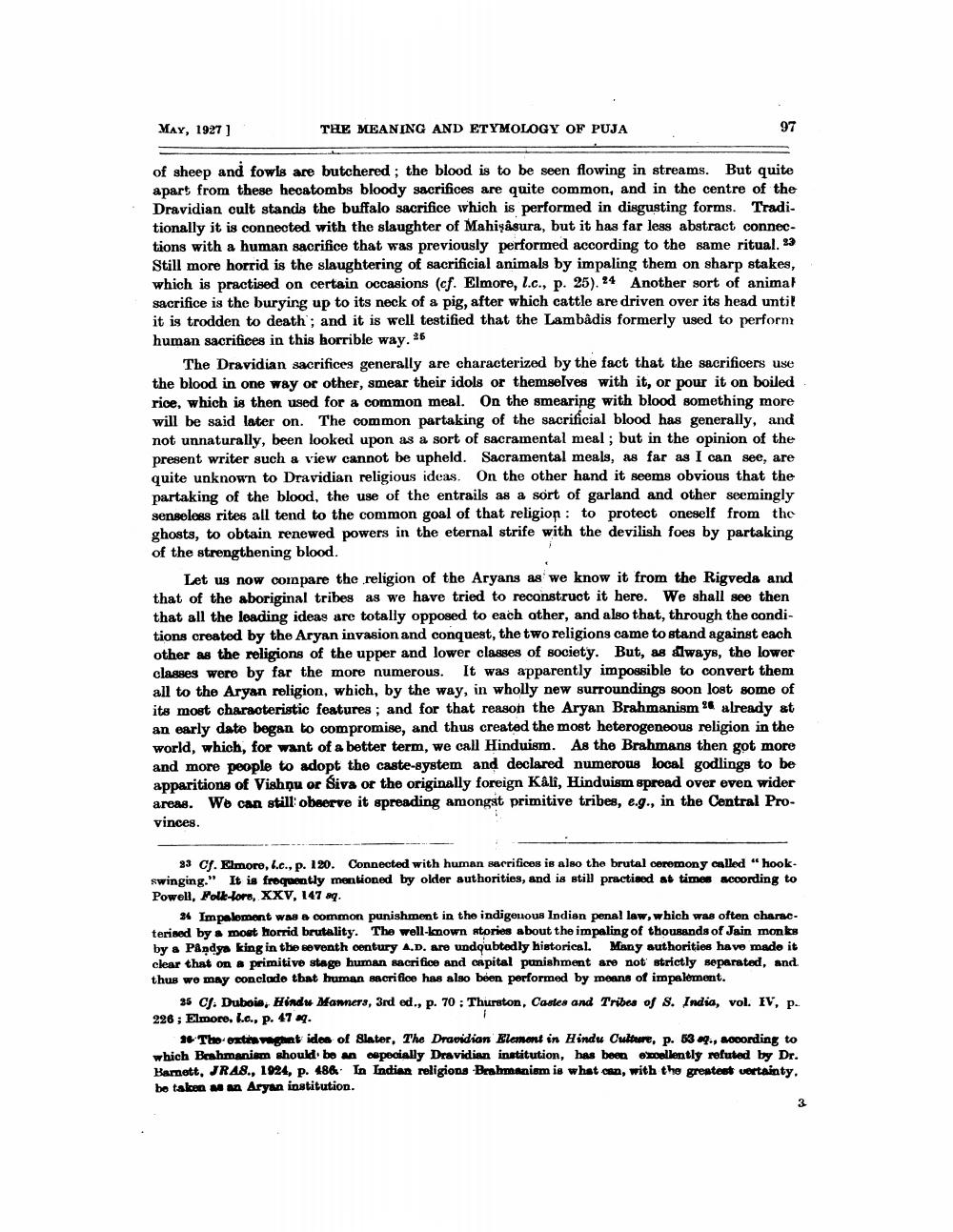________________
MAY, 1927]
THE MEANING AND ETYMOLOGY OF PUJA
of sheep and fowls are butchered; the blood is to be seen flowing in streams. But quite apart from these hecatombs bloody sacrifices are quite common, and in the centre of the Dravidian cult stands the buffalo sacrifice which is performed in disgusting forms. Traditionally it is connected with the slaughter of Mahişâgura, but it has far less abstract connections with a human sacrifice that was previously performed according to the same ritual. 23 Still more horrid is the slaughtering of sacrificial animals by impaling them on sharp stakes, which is practised on certain occasions (cf. Elmore, 1.c., p. 25). 24 Another sort of animal sacrifice is the burying up to its neck of a pig, after which cattle are driven over its head until it is trodden to death'; and it is well testified that the Lambådis formerly used to perform human sacrifices in this horrible way. 26
The Dravidian sacrifices generally are characterized by the fact that the sacrificers use the blood in one way or other, smear their idols or themselves with it, or pour it on boiled rice, which is then used for a common meal. On the smearing with blood something more will be said later on. The common partaking of the sacrificial blood has generally, and not unnaturally, been looked upon as a sort of sacramental meal; but in the opinion of the present writer such a view cannot be upheld. Sacramental meals, as far as I can see, are quite unknown to Dravidian religious ideas. On the other hand it seems obvious that the partaking of the blood, the use of the entrails as a sort of garland and other seemingly senseless rites all tend to the common goal of that religion: to protect oneself from the ghosts, to obtain renewed powers in the eternal strife with the devilish foes by partaking of the strengthening blood.
Let us now compare the religion of the Aryans as we know it from the Rigveda and that of the aboriginal tribes as we have tried to reconstruct it here. We shall see then that all the loading ideas are totally opposed to each other, and also that, through the conditions created by the Aryan invasion and conquest, the two religions came to stand against each other as the religions of the upper and lower classes of society. But, as always, the lower classes were by far the more numerous. It was apparently impossible to convert them all to the Aryan religion, which, by the way, in wholly new surroundings soon lost some of its most characteristic features ; and for that reason the Aryan Brahmanism already at an early date began to compromise, and thus created the most heterogeneous religion in the world, which, for want of a better term, we call Hinduism. As the Brahmans then got more and more people to adopt the caste-system and declared numerous local godlings to be apparitions of Vishnu or Siva or the originally foreign Kali, Hinduism spread over even wider areas. Wo can still observe it spreading amongst primitive tribes, e.g., in the Central Provinces.
33 C. Elmoro, 1.c., p. 120. Connected with human sacrifices is also the brutal ceremony called "hookswinging." It is frequently mentioned by older authorities, and is still practised at times according to Powell, Folklore, XXV, 147 sq.
34 Impalomont was common punishment in the indigenous Indian penal law, which was often characterised by a moet horrid brutality. The well-known stories about the impaling of thousands of Jain monks by a Pandya king in the seventh century A.D. are undoubtedly historical. Many authorities have made it clear that on a primitive stage human sacrifice and capital punishment are not strictly separated, and thus we may conclude that human sacrifice has also been performed by means of impalement.
35 Cf. Dubois, Hindu Manners, 3rd ed., p. 70: Thurston, Castes and Tribes of 8. India, vol. IV, p. 226; Elmore. Lc., p. 47 sq.
1. The extnacht idea of Slater, The Dravidian Element in Hindu Culture, p. 53 a., according to hich Bohmaniam should be an epocially Dravidian institution, has been emoellently refuted by Dr. Kamott, JRA8., 1924, p. 486 In Indian religions Brahmanism is what can, with the greatest vertainty. be taken man Aryan institution.




